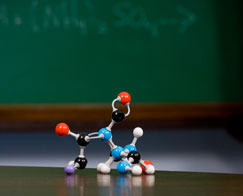Collaboration Across Cultures

Student Worksheet: Identifying Light Energy by Temperature Changes
Procedure
- As illustrated in the diagram set up your apparatus. Straighten out the paper clip and carefully thread the peanut onto the paper clip. You want to avoid as much as possible cracking the peanut.
- Measure out 50 ml of water and pour the water into the flask. Determine the mass of 50 ml of water. Record the initial temperature of the water.
- Place the small aluminun pan with peanut underneath the flask with the water in it. Using a match, light the peanut and allow it to burn. Make sure the apparatus is closely set up so that a large amount of heat is not lost into the air.
- Record the final temperature of water after the peanut has stopped burning.
- Answer the Think About questions on paper.
Think About
- Describe what happened to the final temperature of water and explain why.
- The energy emitted from the peanut is mostly infrared light (heat). Review the electromagnetic spectrum diagram. What would happen to the temperature of the water if the peanut were to emit the same number of photons but as ultraviolet light? Hint: Compare the energy of infrared and ultraviolet light.
- Explain how you could use the temperature change of the water to create a spectrum of the light energy released by the burning peanut.
- Relate this experiment to how a microcalorimeter works.

Teacher's Corner